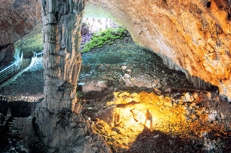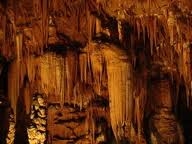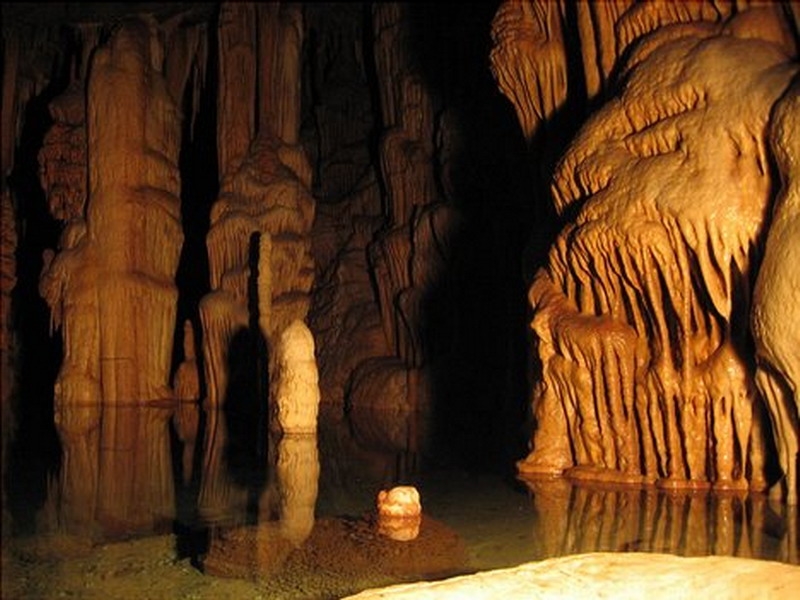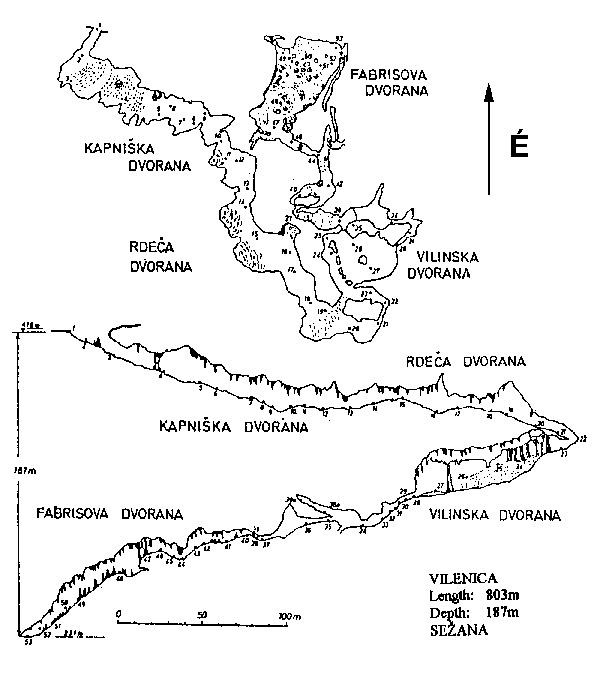Vilenica Cave
General information:
Vilenica is the oldest cave in Europe. It was named after haze lifting above its entrance and dancing like mythological creatures - fairies.The cave consists of three morphologically characteristic parts, all of them transformed by breakdowns.Vilenica is about 800 m long cave with denivelation of about 180 m. The cave is well decorated with a series of nice speleothems. The cave is noted for large halls and rich flowstone decoration. There are many nice draperies. A gigantic stalagmite having 10 m in diameter in its lower part, probably the largest speleothem (speleothems are cave formations such as stalactites and stalagmites) in Slovenia, is an outstanding feature in this cave.



Geological information and uniqueness of the cave:
The first part is very large and strongly controlled by breakdown. The central part is smaller and the third part, consisting of the Fabrisov Rov gives an impression of a large, inclined fissure. There is an outstanding stalagmite. Stalagmite is a type of speleothem that rises from the floor of a limestone cave to the dripping of mineralized solutions the deposition of calcium carbonate.
According to old beliefs, fairies lived in the bottom of the cave giving the name to it (vila (fairy) - Vilenica). The final part named Fabrisov Rov, is accessible to cavers only. In this part there are red stalactites covered by white helictites. A helictite is a speleothem found in limestones caves that changes its axis from the vertical at one or more stages during its growth. They have a curving or angular form that looks as if they were grown zero gravity. Helictites are, perhaps, the most delicate of cave formations. In this cave they are made of needle calcite (can be aragonite). Forms of helictites have been described in several types like ribbon, saws, rods, curly-fries, but in this cave they are like butterflies. They can be very easily crushed or broken by the slightest touch. Becouse of this, helictites are rarely seen within arm's reach in tourist caves.
The main body of the cave has developed inside a fissure zone. Irrespective of how the primary passages inside this zone were directed, ceiling collapses are mostly controlled by faults. A fault is a planar fracture or discontiunity in a volume of rork, accross which there has been significant displacement.
It is interesting that the orientation of the show part is almost entirely perpendicular to recent underground conduits. The divergence may be explained by the great age of the cave and it is quite possible that the underground water flows that shaped it, were oriented differently than today. A hypothesis exists that the accessible cave makes just one part of former bigger cave system. Anyway due to intensive passage collapse the information about the original conditions are in many places completely blurred.

Access to the cave:
from the main road is approximately 200m. There is nice parking place (see the reference point). The cave is not open every day. Opening hours are described in the spoiler picture (info table picture)
Please send me your responses to the logging tasks (email Aucoin.J@seznam.cz), then go ahead and log this EarthCache. You do not need to wait for my response to post your log. If there is a problem with your log or logging tasks, I will contact you. Please do not include any information in your log that may spoil the logging tasks for others.
1. how high is the gigantic stalagmite and doest it have name? Describe the colour of the gigantic stalagmite.
2. how did this gigantic stalagmite grow and how long did it take?
Take a picture of youself with GPS showing the infotable in the background. See reference point for infotable spot. The picture is optional.
Slovenščina – Splošne informacije in geologija:
Vilenica je najstarejša turistično urejena jama v Evropi. Ime je dobila po meglicah nad vhodom, ki so videti kot ples mitoloških bitij - vil. Zato so bili ljudje prepričani, da v jami živijo vile. Jama je sestavljena iz treh morfološko bistvenih delov, ki so bili preoblikovani zaradi vode in ponorov kakšnega (občasnega) potoka. Vilenica je več kot 800 m dolga jama z denivelacijo dobrih 180 m. Jama je bogato okrašena z vrsto lepih kapnikov. Znana je po velikih dvoranah in bogati dekoraciji sigastih tvorb. Še posebej so lepe jamske zavese in velikanski stalagmit s premerom 10 metrov v njegovem spodnjem delu, verjetno največja kapniška tvorba v Sloveniji.
Prvi del jame je bil močno preoblikovan s ponorom. Osrednji del je manjši. Zadnji del daje vtis velikega, poševnega zloma. V zadnjem delu jame lahko najdemo izjemni stalagmit. Stalagmit je kapnik, ki raste iz tal in nastaja s kapljanjem vode iz stropa in izločanjem kalcijevega karbonata iz nje. Tretji del se zaključi s Fabrisovim rovom, ki je dostopen samo jamarjem. V tem delu so rdeči stalaktiti, prekriti z belimi helictiti. To so apnenčaste tvorbe, ki spreminjajo svojo rast od vertikalne v več stopnjah. Zato imajo skrivljeno ali kotno obliko, ki daje vtis, kot da so brez težnosti. V tej jami so narejeni iz igel kalcita (lahko tudi aragonita). So morda ena od najbolj občutljivih jamskih tvorb. Že ob najmanjšem stiku se jih lahko zmečka ali zdrobi. Zato se jih v turističnih jamah tudi redko vidi na dosegu roke obiskovalcev. Oblike helictitov opisujejo glede na obliko kot trak, žaga, palica, kodrčki, krompirček, toda v tej jami so podobni metuljem.
Glavni del jame se je razvil znotraj območja razpoke. Ne glede na to, kako so bile prvotno razporejeni prehodi znotraj tega območja, je na mestih prelomnic prišlo do zrušitev stropov. Prelomnica je zlom ali prekinitev v skalni masi, do katere pride zaradi vzdolžnih zlomov, ki so posledica zemeljskega gibanja.
Zanimivo je, da je usmeritev vidnih delov skoraj povsem pravokotna na mlajše podzemne vode. Razlike je mogoče pojasniti z veliko starostjo jame, zaradi katerih je dokaj možno, da so bile podzemne vode, ki so jih oblikovale, usmerjene drugače kot so danes. Domnevajo, da je današnja jama samo del nekdanjega večjega jamskega sistema. Kakorkoli, zaradi intenzivnih podorov so podatki o prvotnem izgledu podzemlja v tem delu na veliko delih povsem zabrisani.
Dostop do jame:
Od glavne ceste je jama oddaljena približno 200m. Pred vhodom je urejeno parkirišče (glej referenčno tocko). Jama ni odprta vsak dan. Čase ogledov si lahko pogledate na sliki spodaj, kjer je slika informacijske table.
Prosim, pošljite mi odgovor na postavljena vprašanja na e-mail: Aucoin.J@seznam.cz, potem pa lahko logiraš svojo najdbo. Ni vam treba čakati dovoljenja. Če bodo težave pri odgovorih, bom stopil v stik z vami. Prosim, da v log ne pišete odgovorov na vprašanja, s katerimi bi drugim onemogočili, da samostojno rešijo nalogo.
Vprašanja:
1. Kako visok je največji kapnik v jami in ali ima kakšno ime? Opišite barvo tega velikanskega stalagmita.
2. Kako je ta velikanski stalagmit rastel in kako star je?
Neobvezno pripnite k svojemu logu sliko sebe in svoje gps naprave pred informacijsko tablo (glej spoiler sliko).
*******************************************************************************************************************************

Have you found or placed a few Earthcaches and would like to show off your achievement? Would you like to place your own? Visit Earthcache.org to create one or request your Earthcache Master Pin.
Ali ste našli ali dano nekaj Earthcaches in bi želeli pokazati svoje dosežke? Bi radi, da se svoje? Obisk Earthcache.org za ustvarjanje ene ali zahteva vaše Earthcache Master Pin.